Weekly Current Affairs (22nd to 31st March 2025) - 1 | Weekly Current Affairs - UPSC PDF Download
Regulating Big Tech in India
 Why in News?
Why in News?
- The Competition Commission of India (CCI) recently imposed a fine of Rs 213 crore on Meta and enforced a five-year ban on sharing user data collected on WhatsApp with other Meta companies such as Facebook and Instagram for advertising purposes. However, the National Company Law Appellate Tribunal (NCLAT) has granted a stay on this ban and penalty. This case highlights the challenges of regulating Big Tech companies and the necessity for a forward-looking competition law framework in India.
Key Takeaways
- The CCI's actions against Meta signify growing scrutiny of Big Tech in India.
- The NCLAT's stay reflects ongoing legal complexities in regulating digital platforms.
- India's current competition laws require updates to address the unique characteristics of digital markets.
Additional Details
- Regulatory Lag: The Competition Act, 2002 lacks provisions for data-centric dominance, focusing instead on traditional market dynamics like price and output.
- Fragmented Governance: Regulatory bodies, including the CCI and the Ministry of Electronics and Information Technology (MeitY), operate without sufficient coordination, and the proposed Data Protection Board under the Digital Personal Data Protection (DPDP) Act of 2023 has not yet been established.
- Legal Ambiguity: Existing laws, such as the Information Technology Act, 2000, are vague regarding AI-generated content and data flows, allowing digital platforms to exploit these ambiguities.
- Global Nature of Tech Firms: Tech firms operate globally, complicating enforcement of national laws. For example, Meta faces regulatory scrutiny from the US, EU, and Australia.
- AI and Emerging Technologies: Current regulations do not adequately address accountability for AI-generated content, such as automated decisions and deepfake distribution.
- Platform Power: Tech giants like Google dominate app stores and advertising, limiting competition and creating unfair advantages for their services.
In light of these challenges, it's evident that major economies are taking significant steps to regulate Big Tech. The US emphasizes antitrust reforms, while the European Union's Digital Markets Act (DMA) imposes stringent rules on tech giants to prevent anti-competitive behavior. Effective reforms are essential to ensure fair competition and protect consumer data.
Necessary Reforms to Regulate Big-Techs
- Digital Competition Act: A proposed act aims to regulate Big Tech and reinforce the CCI's capabilities in addressing data dominance and platform lock-ins.
- Fast-Track Dispute Resolution: Establishing a Digital Market and Data Unit (DMDU) within the CCI for timely handling of cases.
- Promote Fair Competition: Creating a central data-sharing repository to ensure fair access to anonymized data for all tech firms.
- Multidisciplinary Enforcement: Developing integrated frameworks similar to the EU's DMA that combine privacy and competition concerns.
- Ex-Ante Regulations: Shifting focus from ex post to ex ante evaluations to prevent monopolistic behavior before it occurs.
- Transparency in Algorithms: Mandating disclosures regarding algorithmic decision-making and biases to enhance accountability.
- Transnational Framework: Crafting robust data protection laws akin to the California Consumer Privacy Act (CCPA) to address the global nature of tech firms.
Ultimately, addressing the complexities of digital market dominance requires a comprehensive approach that combines regulatory reforms with effective enforcement mechanisms to foster a competitive landscape.
India’s Strategy to Eliminate Naxalism
Why in News?
- The Union Home Minister recently declared that the central government is making significant efforts to achieve a Naxal-free India, with a target set for elimination of Naxalism by 31 March 2026. The aim is to ensure that no citizen loses their life due to this insurgency.
Key Takeaways
- The government is implementing a multi-faceted approach to combat Naxalism.
- Social and developmental initiatives are essential components of the strategy.
- Security measures include large-scale operations and enhanced police presence in affected areas.
Additional Details
- Development Programs: Under the Seventh Schedule of the Indian Constitution, police and public order are primarily state responsibilities. To address Left-Wing Extremism (LWE), the National Policy and Action Plan was adopted in 2015, incorporating development initiatives such as the Pradhan Mantri Gram Sadak Yojana II, which improves road connectivity in LWE-affected areas.
- Programs like the ROSHNI Scheme provide training and employment opportunities for rural youth, while 130 Eklavya Model Residential Schools (EMRS) enhance educational access in tribal regions.
- Communications are improved through the Universal Service Obligation Fund Scheme, now known as Digital Bharat Nidhi, which installs mobile towers in remote areas.
- Security Operations: Operations such as Operation Green Hunt involve deploying paramilitary forces to eliminate Naxalite presence, supported by increased Central Armed Police Forces (CAPFs) and specialized units.
- Legal Framework: The Unlawful Activities (Prevention) Act (UAPA) of 1967 prohibits Naxalite organizations, while the Forest Rights Act, 2006, and the Panchayats (Extension to Scheduled Areas) Act (PESA) of 1996 protect tribal rights and empower local governance.
- The Surrender-cum-Rehabilitation Policy provides financial assistance and vocational training for surrendered Naxals to reintegrate them into society.
Significant progress has been made, with the number of LWE-affected districts decreasing from 126 in 2014 to just 12 in 2024. Naxal-related incidents fell from 16,463 between 2004-2014 to 7,700 from 2014-2024. Casualties among security forces due to Naxalism have decreased by 73%, and civilian casualties by 70%. Additionally, fortified police stations have increased from 66 in 2014 to 612 in 2024.
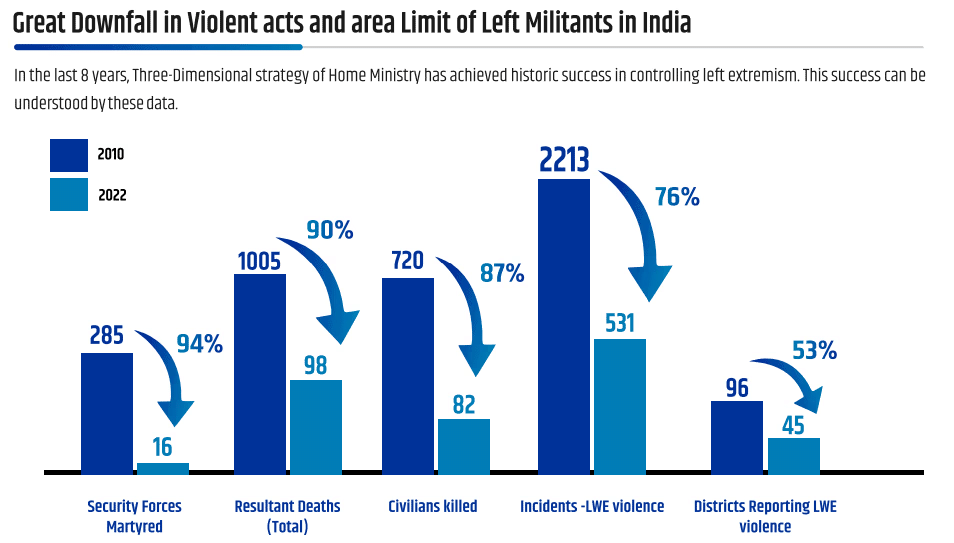
What is Naxalism?
Naxalism is an insurgent movement inspired by Maoist ideology, aiming to overthrow the state through armed rebellion, including violence and guerrilla warfare. The term originates from Naxalbari, a village in West Bengal where a peasant uprising occurred in 1967 against oppressive landlords, evolving into a complex insurgency impacting several Indian states.
Causes for Naxalism
- Landlessness and Exploitation: Disparities in land distribution and exploitative practices by landlords and moneylenders fuel anger in rural and tribal communities.
- Poverty and Underdevelopment: A lack of basic amenities such as healthcare and education in Naxalite-affected regions drives people towards extremism.
- Tribal Alienation: Displacement from industrial and mining projects without proper rehabilitation creates resentment towards the state.
- State Neglect and Violence: Weak government presence and police excesses, including custodial deaths, exacerbate grievances, strengthening the insurgency.
Indian Maoists
The Communist Party of India (Maoist) is the most prominent and violent Maoist faction in India, formed through the merger of CPI (Marxist-Leninist) People’s War and the Maoist Communist Centre of India. This group has been banned under the UAPA, 1967.
Geographic Spread
The Naxal movement is primarily active in the "Red Corridor," which encompasses parts of several Indian states, including Chhattisgarh, Jharkhand, Odisha, Maharashtra, and Bihar.
Mains Question:
- Discuss the factors that contributed to the rise of Naxalism in India and analyze the government’s approach to countering it.
Judicial Transfers and In-House Inquiry
Why in News?
- The Supreme Court (SC) Collegium has recommended the transfer of Delhi High Court Judge Justice Yashwant Varma to the Allahabad High Court. This decision follows allegations regarding the discovery of sacks of burnt currency at his residence. Concurrently, an in-house inquiry procedure has been initiated by Chief Justice of India (CJI) Sanjiv Khanna to investigate the incident more thoroughly. This action reflects the commitment to uphold the Restatement of Values of Judicial Life, ensuring judicial integrity and accountability.
Key Takeaways
- The transfer of Justice Varma is linked to serious allegations of misconduct.
- The in-house inquiry aims to uphold judicial standards and investigate the claims thoroughly.
Additional Details
- Judicial Transfers: The process is governed by Article 222 of the Indian Constitution, which allows the President to transfer judges based on the CJI's recommendations. Notably, consent from the judge is not required for any transfer.
- The CJI plays a crucial role in initiating transfer proposals, consulting with relevant Chief Justices and Supreme Court judges regarding the performance of the concerned judge.
- Role of the Executive: The Union Law Minister forwards the Collegium's recommendation to the Prime Minister, who then advises the President for approval. The transfer is subsequently notified through the Gazette of India.
- Importance of Transfers: Transfers help optimize judicial efficiency, prevent undue influence, and preserve public trust by addressing concerns about impartiality.
- In-House Inquiry: This mechanism was established in 1999 following the C. Ravichandran Iyer case to handle allegations against judges that do not meet the threshold for impeachment. It begins when a complaint is received by the CJI or other high-ranking officials.
- If a complaint is deemed credible, a preliminary inquiry is conducted, leading to a detailed investigation if necessary, overseen by a three-member committee.
- Outcomes can range from warnings for minor misconduct to recommendations for resignation or impeachment for serious misconduct.
The developments surrounding the transfer of Justice Varma and the initiation of the in-house inquiry underscore the importance of maintaining judicial integrity and accountability within the Indian legal system.
Migration Trends in India post-Covid-19
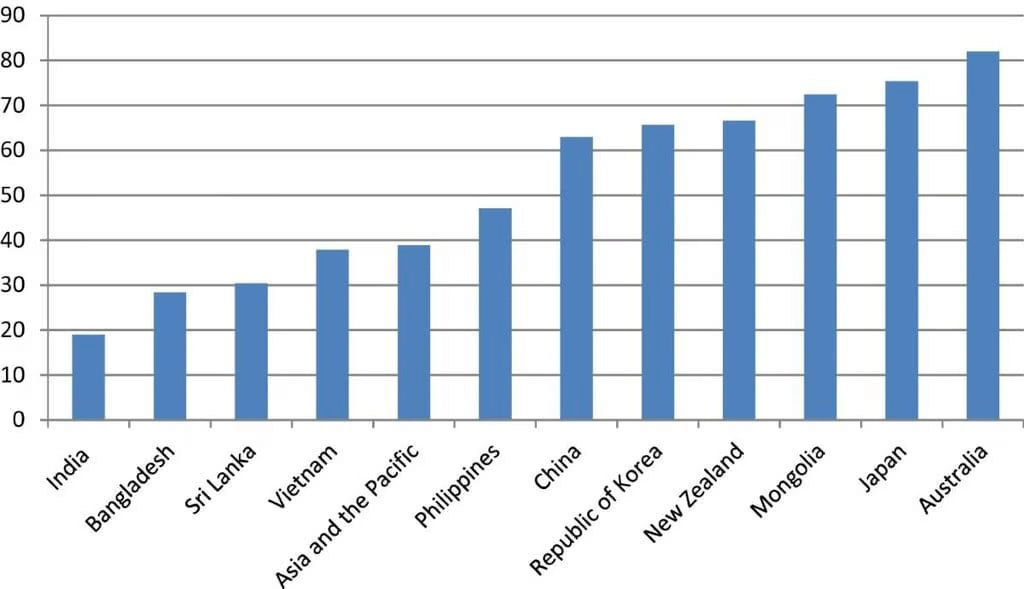 Why in News?
Why in News?
- Five years after the Covid-19 pandemic, migration patterns in India have undergone significant changes. While rural-to-urban migration has picked up again, international emigration has seen diversification. Understanding these trends and improving migration governance is vital for addressing the challenges faced by migrants and maximizing the advantages of migration.
Key Takeaways
- The Covid-19 crisis prompted unprecedented urban-to-rural reverse migration, with approximately 44.13 million moving from urban areas to rural regions during the first lockdown.
- Returning migrants, largely low-skilled workers, encountered numerous issues such as wage theft, food insecurity, and lack of healthcare.
- The rebound of rural-to-urban migration is evident as urban aspirations and inadequate rural employment push migrants back to cities.
- Climate change is increasingly influencing migration trends, particularly from agrarian states like Odisha.
- Post-Covid, many Indian migrants are shifting from the Gulf countries to advanced economies for better prospects.
Additional Details
- Urban to Rural Migration: The reverse migration saw 44.13 million individuals moving to rural areas during the first lockdown, followed by 26.3 million in the second lockdown. Many returning migrants faced challenges such as economic strain and lack of job opportunities.
- Rebound of Rural-to-Urban Migration: Rural economies struggled to absorb the returning workforce, leading to a resurgence of urban migration driven by aspirations and inadequate employment in rural areas.
- Climate-Induced Migration: There is a notable influence of climate change on migration, particularly affecting agrarian states, highlighting the need for recognition in migration policies.
- International Migration Shifts: Despite challenges during the pandemic, remittances remained strong, with a shift in Indian migrants towards advanced economies for improved job opportunities.
- Challenges in Migration Governance: Inadequate migration data systems, weak implementation of social security schemes, and neglect of vulnerable groups, such as women and children, pose significant challenges to effective governance.
In conclusion, the post-Covid-19 migration landscape in India reveals complex trends that necessitate robust governance frameworks to support migrants effectively. Addressing the challenges and leveraging the benefits of migration will be crucial for India's socio-economic development.
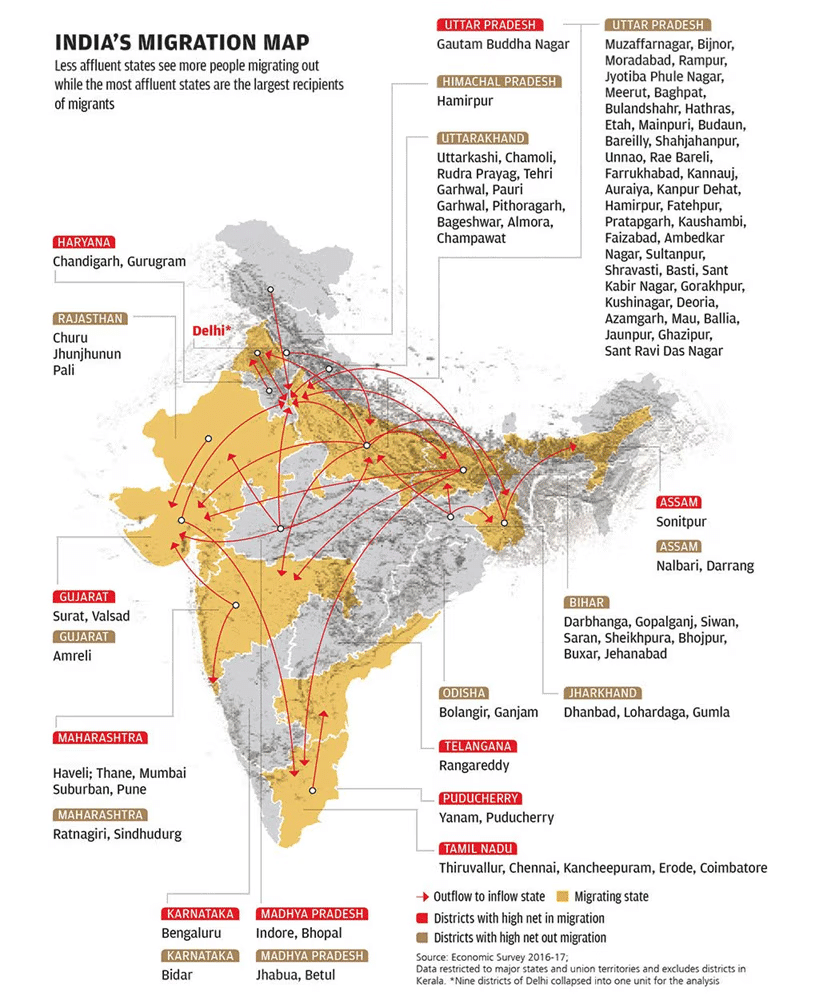
Route for IORA Under India’s Chairship
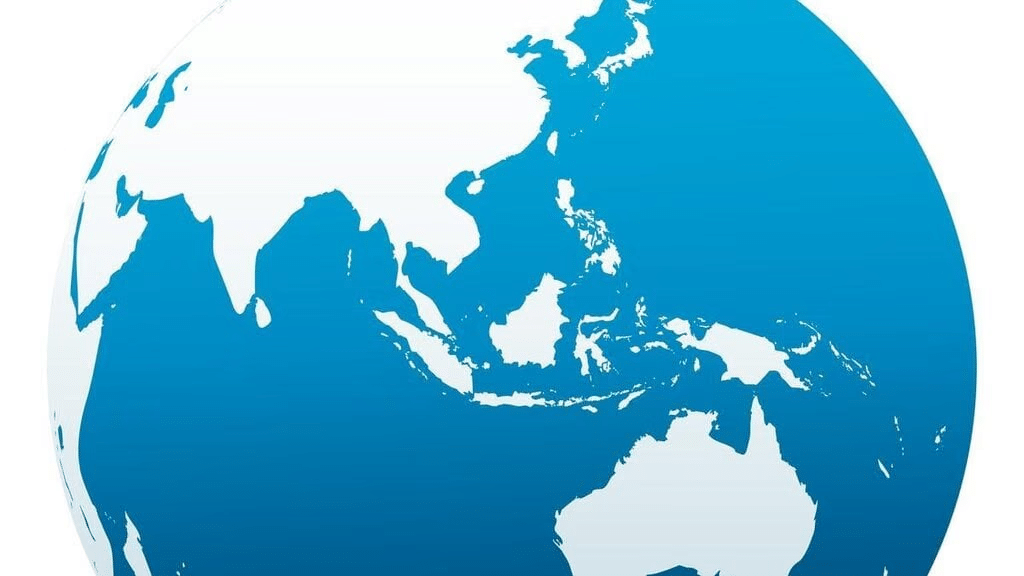 Why in News?
Why in News?
- As India prepares to assume the role of Chair of the Indian Ocean Rim Association (IORA) in November 2025, transitioning from its current vice chair position, it aims to enhance the organization’s governance. India intends to increase IORA's budget, improve data management through technology, and collaborate with educational institutions to create maritime courses over the next two years.
Key Takeaways
- India will take over the IORA chairmanship in November 2025.
- Plans to enhance governance and budget of IORA.
- Focus on technology and educational collaboration for maritime courses.
Additional Details
- Indian Ocean Rim Association (IORA): An intergovernmental organization established to foster economic cooperation and regional integration among countries bordering the Indian Ocean.
- IORA membership includes 23 member states and 10 dialogue partners, facilitating initiatives related to trade, investment, and sustainable development across Asia, Africa, and Oceania.
- Background: Established on March 7, 1997, the vision for IORA originated during a visit by Nelson Mandela to India in 1995, leading to the formation of the Indian Ocean Rim Initiative.
- India’s Role: India’s alignment with the Security and Growth for All in the Region (SAGAR) vision emphasizes maritime security and sustainable development.
Importance of IORA in the Indian Ocean Region
- IORA plays a crucial role in regional cooperation, fostering multifaceted collaborations among its member states.
- Facilitates structured dialogues and cultural exchanges, enhancing regional resilience in areas like disaster risk management.
- Influences the agenda through middle and small powers, despite engagement from global powers.
Challenges Faced by IORA
- Financial Constraints: IORA operates on a limited budget, primarily reliant on member-state contributions, which restricts its operational capacity.
- Many members are developing economies, which exacerbates financial instability.
- Resource-Intensive Areas: Expanding mandates in maritime safety and disaster management require sustained financial resources.
- Private Sector Involvement: Difficulty in attracting engagement from key maritime industries limits funding and operational efficiency.
- Limited Institutional Capacity: The small workforce at the Secretariat in Mauritius hampers effective management and strategic functions.
- Challenges in Data Management: Lack of advanced systems leads to inefficiencies and errors in policy-making.
To build a skilled maritime workforce, India must foster collaborations between industry and academia, introducing specialized courses in critical areas. Strengthening partnerships is essential for driving innovation and addressing regional challenges, ensuring economic sustainability. As India leads IORA, enhancing regional cooperation and resource mobilization will be key to maximizing its impact.
Mains Question:
Examine India's strategic role in IORA. How can India leverage investments and traditional knowledge for sustainable regional governance?
Gross Fixed Capital Formation
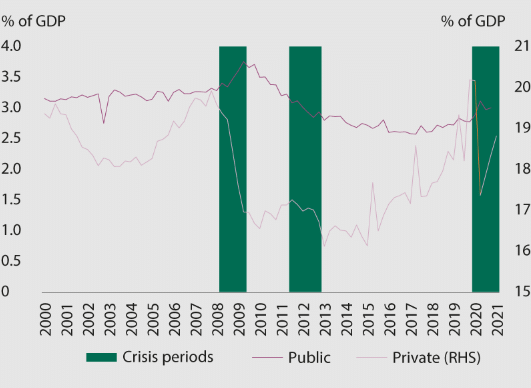
Why in News?
- The share of private capital expenditure (capex) in India’s Gross Fixed Capital Formation (GFCF) has declined to a decade-low of 33% in FY24.
Key Takeaways
- GFCF is crucial for long-term economic growth.
- It constitutes around 30% of India's nominal Gross Domestic Product (GDP).
- The growth of GFCF has slowed down significantly since FY23.
Additional Details
- Gross Fixed Capital Formation (GFCF): Also referred to as "investment," GFCF represents the net increase in an economy's fixed capital assets over a specific period, including infrastructure and durable goods.
- GFCF is a vital component of Gross Capital Formation (GCF), which also includes changes in stocks and the net acquisition of valuables.
- From FY15 to FY24, GFCF grew at a compounded annual growth rate (CAGR) of 10%, but growth has moderated significantly, falling to 9% in FY24 from 20% in FY23.
- The decline in private capex share is attributed to a contraction in unlisted entities and external factors such as global slowdowns and weak export demands.
- The cash flow from operations to capex ratio has increased, yet firms are prioritizing debt repayment over new investments.
A decline in GFCF has significant implications, limiting productive capacity and job creation. It can delay infrastructure development and reduce private sector participation, signaling weak investor confidence, which may deter foreign direct investment (FDI). Furthermore, it leads to over-reliance on public spending, which is unsustainable and may hinder innovation and inclusive growth.
What Can Be Done to Revive Private Capex and GFCF?
- Boost Domestic Consumption: Fast-tracking the 8th Pay Commission and increasing MNREGA wages can enhance rural spending and overall demand.
- Strengthen Exports and Imports: Finalizing Free Trade Agreements (FTAs) with the UK and the EU can integrate Indian businesses into global supply chains.
- Private Sector R&D and Innovation: The Rs 1 lakh crore innovation corpus (Budget 2024-25) should be operationalized to enhance competitiveness.
- Industrial Infrastructure: Granting infrastructure status to the hospitality sector may attract private investments.
- Sustainable Growth: Scaling up green finance through sovereign green bonds can fund climate adaptation projects and draw private investments.
In conclusion, reviving private capital expenditure and GFCF is essential for sustaining economic growth in India. Focused strategies aimed at boosting domestic demand and enhancing competitiveness in global markets will be crucial.
MP Salary Hike vs. Worker Wage Stagnation
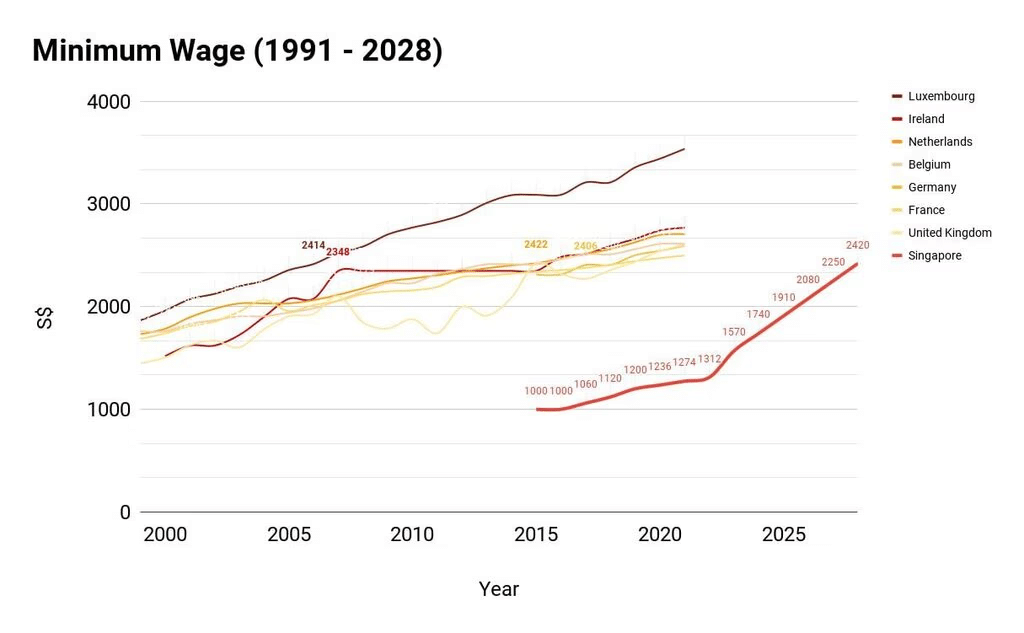 Why in News?
Why in News?
- The Central government has announced a 24% increase in the salaries and pensions of Members of Parliament (MPs), effective retroactively from 1st April 2023. However, the India Employment Report (IER) 2024 indicates stagnation and a decline in real wages for the working population of India, highlighting a growing economic divide.
Key Takeaways
- MP salaries are now revised based on the Cost Inflation Index (CII) every five years.
- Real wages for regular workers have decreased, while self-employed individuals saw slight increases.
- The wage stagnation raises concerns about democratic accountability and governance priorities.
Additional Details
- Legal Framework: Since 2018, MPs' salaries and pensions are adjusted every five years according to the Cost Inflation Index (CII), established under the Finance Act, 2018, which amended the Salaries, Allowances, and Pension of Members of Parliament Act, 1954.
- Cost Inflation Index (CII): The CII is issued annually under Section 48 of the Income Tax Act, 1961. It adjusts the purchase price of assets for inflation, helping to ensure that taxpayers do not incur excessive taxes on long-term capital gains due to asset price increases.
- The CII for FY 2024-25 is 363, indicating a price increase of 3.63 times since the base year of 2001.
- Average real wages for regular salaried workers fell from Rs 10,925 in 2022 to Rs 10,790 in 2023, while casual wages slightly declined from Rs 4,712 to Rs 4,671.
- The report highlights a weak quality of employment generation despite rising Gross Domestic Product (GDP).
Concerns arise from the disparity between the rising salaries of political leaders and the stagnation of wages for workers, which may undermine democratic accountability and foster perceptions of self-serving governance. The average income of a retired MP exceeds that of the average Indian, suggesting a widening gap between the rulers and the ruled.
Policy Recommendations
- Need for Systemic Reform: Experts suggest establishing independent emoluments commissions to align pay revisions with economic performance and depoliticize the salary adjustment process.
- Index Minimum Wages to Inflation: Implementing a national wage indexation mechanism can help maintain stable real income for workers.
- Shift from Minimum Wage to Fair Wage: Expand the definition of a decent standard of living, incorporating health, education, housing, and social mobility in line with the Indian Constitution.
- Digital Governance Compliance: Utilize platforms such as the e-Shram portal and EPFO databases to monitor wage compliance, especially in the informal sector.
- Pay Commission for Wage Parity: Align government salaries with inflation and economic conditions to achieve a balanced income structure across public and private sectors.
Addressing the wage-inflation gap through these reforms is crucial for ensuring inclusive growth and maintaining the integrity of democratic institutions.
|
287 docs|142 tests
|
FAQs on Weekly Current Affairs (22nd to 31st March 2025) - 1 - Weekly Current Affairs - UPSC
| 1. What are the key strategies India is adopting to regulate Big Tech companies? |  |
| 2. How is India addressing the issue of Naxalism? |  |
| 3. What are the implications of judicial transfers and in-house inquiries in the Indian legal system? |  |
| 4. What migration trends have been observed in India post-Covid-19? |  |
| 5. How does Gross Fixed Capital Formation (GFCF) impact India's economy? |  |
















